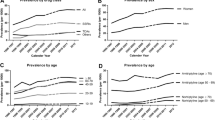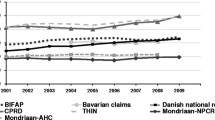Abstract
Objectives
The use of antidepressants has increased over the years, which may be due to more new antidepressant users, but also may be due to a longer duration of use. We aimed to assess the prevalence, incidence and average duration of selective serotonin reuptake inhibitor (SSRI) and tricyclic antidepressant (TCA) use in the Netherlands during 1992–2001. In addition, we assessed the incidence of long-term use of SSRIs and identified possible determinants of long-term use.
Methods
We assessed prevalence (number of current users of an antidepressant per 1000 persons assessed on a single day) and incidence (number of new users per 1000 persons per year) of antidepressant use for each year in the PHARMO record linkage system. Long-term use was defined as the consecutive use of any antidepressant for at least 12 months. Relative risks and hazard ratios were calculated and adjusted for possible determinants using Poisson and Cox regression analyses.
Results
Both prevalent and incident use of SSRIs increased during 1992–2001, while TCA use remained stable. A total of 9857 patients using SSRIs were included in a follow-up study. During the follow-up period, more patients became long-term users, either directly after the start of the initial SSRI or anytime during follow-up (29.5%). The average number of days before start of long-term use decreased from 595 days in 1991 to 19 days in 1997. Female patients, older age, previous use of benzodiazepines and being treated by a psychiatrist increased the probability of becoming a long-term user.
Conclusion
Both prevalent and incident use of SSRIs increased during the 1990s, implicating an increased number of patients starting SSRIs, but also a longer duration of use of antidepressant therapy. Over the entire follow-up period, almost 30% of the patients became long-term users at anytime during the follow-up period.

Similar content being viewed by others
References
Rosholm JU, Andersen M, Gram LF (2001) Are there differences in the use of selective serotonin reuptake inhibitors and tricyclic antidepressants? A prescription database study. Eur J Clin Pharmacol 56:923–929
Anderson IM, Nutt DJ, Deakin JF (2000) Evidence-based guidelines for treating depressive disorders with antidepressants: a revision of the 1993 British Association for Psychopharmacology guidelines. J Psychopharmacol 14:3–20
American Psychiatric Association (2000) Practice guidelines for major depressive disorders in adults. Am J Psychiatry 157:1–26
de Groot PA (1995) Consensus depression in adults. Dutch Association for Psychiatry. Ned Tijdschr Geneeskd 139:1237–1241
Herings RM, Bakker A, Stricker BH, Nap G (1992) Pharmaco-morbidity linkage: a feasibility study comparing morbidity in two pharmacy based exposure cohorts. J Epidemiol Community Health 46:136–140
Anonymous (1994) Anatomical therapeutic Chemical (ATC) classification index. WHO Collaborating Centre for Drug Statistics Methodology, Oslo
Sclar DA, Skaer TL, Robison LM, Galin RS, Legg RF, Nemec NL (1998) Economic outcomes with antidepressant pharmacotherapy: a retrospective intent-to-treat analysis. J Clin Psychiatry 59[Suppl 2]:13–17
Olfson M, Marcus SC, Pincus HA, Zito JM, Thompson JW, Zarin DA (1998) Antidepressant prescribing practices of outpatient psychiatrists. Arch Gen Psychiatry 55:310–316
Hemels ME, Koren G, Einarson TR (2002) Increased use of antidepressants in Canada: 1981–2000. Ann Pharmacother 36:1375–1379
Angst J, Merikangas K (1997) The depressive spectrum: diagnostic classification and course. J Affect Disord 45:31–40
Garrison GD, Levin GM (2000) Factors affecting prescribing of the newer antidepressants. Ann Pharmacother 34:10–14
Isacsson G, Boethius G, Henriksson S, Jones JK, Bergman U (1999) Selective serotonin reuptake inhibitors have broadened the utilisation of antidepressant treatment in accordance with recommendations. Findings of a Swedish prescription database. J Affect Disord 53:15–22
Anderson I (2000) Selective serotonin reuptake inhibitors versus tricyclic antidepressants: a meta-analysis of efficacy and tolerability. J Affect Disord 58:19–36
Frank E, Kupfer DJ, Perel JM, Cornes C, Jarrett DB, Mallinger AG, Thase ME, McEachran AB, Grochocinski VJ (1990) Three-year outcomes for maintenance therapies in recurrent depression. Arch Gen Psychiatry 47:1093–1099
Kupfer DJ, Frank E, Perel JM, Cornes C, Mallinger AG, Thase ME, McEachran AB, Grochocinski VJ (1992) Five-year outcome for maintenance therapies in recurrent depression. Arch Gen Psychiatry 49:769–773
Geddes JR, Carney SM, Davies C et al (2003) Relapse prevention with antidepressant drug treatment in depressive disorders: a systematic review. Lancet 361:653–661
Dawson R, Lavori PW, Coryell WH, Endicott J, Keller MB (1998) Maintenance strategies for unipolar depression: an observational study of levels of treatment and recurrence. J Affect Disord 49:31–44
American Psychiatric Association (1998) Practice guideline for the treatment of patients with panic disorder. Workgroup on panic disorder. Am J Psychiatry 155:1–34
Kapczinski FSR, Lima MS (2002) The use of antidepressants for Generalized Anxiety Disorder (Cochrane Library). The Cochrane Library, Oxford
Birkenhaeger T, Moleman P, Nolen W (1995) Benzodiazepines for depression? A review of the literature. Int Clin Psychopharmacol 10:181–195
Kotzan JA, Maclean JR, Wade W, Martin BC, Iami H, Tadlock G, Gottlieb M (2002) Prevalence and patterns of concomitant use of selective serotonin reuptake inhibitors and other antidepressants in a high-cost polypharmacy cohort. Clin Ther 24:237–248
Medawar C (1997) The antidepressant web. Marketing depression and making medicines work. Int J Risk Saf Med 10:75–126
Melfi CA, Chawla AJ, Croghan TW, Hanna MP, Kennedy S, Sredl K (1998) The effects of adherence to antidepressant treatment guidelines on relapse and recurrence of depression. Arch Gen Psychiatry 55:1128–1132
Claxton AJ, Li Z, McKendrick J (2000) Selective serotonin reuptake inhibitor treatment in the UK: risk of relapse or recurrence of depression. Br J Psychiatry 177:163–168
Hirschfeld RM (2001) Clinical importance of long-term antidepressant treatment. Br J Psychiatry 42[Suppl]:S4–S8
Author information
Authors and Affiliations
Corresponding author
Rights and permissions
About this article
Cite this article
Meijer, W.E.E., Heerdink, E.R., Leufkens, H.G.M. et al. Incidence and determinants of long-term use of antidepressants. Eur J Clin Pharmacol 60, 57–61 (2004). https://doi.org/10.1007/s00228-004-0726-3
Received:
Accepted:
Published:
Issue Date:
DOI: https://doi.org/10.1007/s00228-004-0726-3




